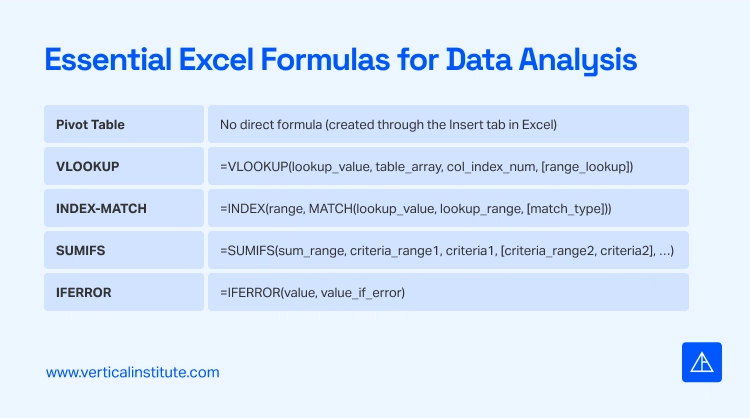Data analysis is a vital skill in today’s digital economy, where every business, no matter the size, relies on data to make informed decisions. Microsoft Excel remains a powerful tool for data analysts, providing robust features that make managing, organising, and analysing data straightforward. Here, we explore some of the best Excel functions for data analysis, which are essential for beginners and experienced professionals.
Related: How To Get Started in Excel?
How Is Excel Used for Data Analysis?
Microsoft Excel is versatile spreadsheet software that allows users to store, organise, and manipulate large data sets. Its functions, formulas, and analytical tools make it one of the most widely used platforms for data analysis across industries.
Related: How Advanced Excel Training Enhances Your Professional Toolkit
Key Applications of Excel in Data Analysis
Data Organisation
Excel simplifies organising raw data into meaningful categories or structured formats, making the data more accessible for analysis.
Visualisation
Data can be visualised using built-in tools like charts, graphs, and pivot tables to extract insights and present results.
Data Cleaning
Excel’s filtering, sorting, and conditional formatting functions allow users to clean datasets, remove inconsistencies, and prepare them for deeper analysis.
Advanced Analysis
More complex features like statistical functions and add-ins like Power Query and Power Pivot allow for handling large datasets and performing complex data manipulations.
For many data analysts, Excel is the first step in understanding and interpreting data before moving on to more advanced tools such as Tableau or SQL for more sophisticated analyses.
Why Learn Excel for Data Analysis?
Regardless of your industry, mastering Excel can significantly boost your career prospects. Excel remains a highly sought-after skill, often a prerequisite for data analysis, finance, marketing, human resources, and more jobs.
Benefits of Learning Excel for Data Analysis
Increased Efficiency
Excel allows users to automate repetitive tasks, saving time and reducing the risk of human error.
Data Management Skills
Mastering Excel equips you with the skills to manage and analyse data, a vital competency in today’s data-driven world.
In-Demand Skill
With industries transforming digitally, the ability to analyse data using Excel is becoming a critical skill across sectors.
Related: Excel Course Duration: How Long It Takes to Learn Excel
Top Excel Functions for Data Analysis
Let’s delve into some of the essential Excel functions for data analysis. These functions help analysts clean, manage, and interpret data more effectively.
1. Pivot Tables
Pivot tables are among the most powerful and flexible tools in Excel. They are used to summarise large datasets and perform comparative analyses. A pivot table allows you to rearrange, group, and summarise data without altering the raw data set, making it indispensable for extracting insights.
How to Create a Pivot Table
- Import your raw data into Excel.
- Label the columns appropriately.
- Highlight the dataset and navigate to the ‘Insert’ tab.
- Select ‘PivotTable’ under the ‘Tables’ section.\
- In the Pivot Table Fields window, drag and drop columns into the Rows, Columns, and Values sections to customise your table.
Pivot tables are commonly used to:
- Analyse sales trends by aggregating data by time periods (months, quarters, years).
- Compare performance between different departments, regions, or product categories.
- Identify key metrics like total sales, average performance, and maximum values.
2. VLOOKUP
VLOOKUP (Vertical Lookup) is a widely used function that searches for a value in a vertical column and returns corresponding data from another column. It is particularly useful for retrieving specific information from large datasets.
The VLOOKUP Formula: =VLOOKUP(lookup_value, table_array, col_index_num, [range_lookup])
- lookup_value: The value you want to search for.
- table_array: The range where the data is located.
- col_index_num: The column number from which you want to retrieve the result.
- range_lookup: Use FALSE for an exact match or TRUE for an approximate match.
Common Uses of VLOOKUP
- Finding product prices or descriptions from a product ID.
- Matching customer information based on a unique identifier such as a customer ID.
- Pulling relevant data from different sheets for report generation.
3. INDEX-MATCH
While VLOOKUP is useful, combining INDEX and MATCH offers more flexibility. Unlike VLOOKUP, which can only search for values to the right, INDEX-MATCH can look in any direction, making it a more powerful tool for searching large datasets.
The INDEX-MATCH Formula: =INDEX(range, MATCH(lookup_value, lookup_range, [match_type]))
- INDEX returns the value of a cell in a specified range.
- MATCH locates the position of the lookup value within a range.
Why Use INDEX-MATCH?
- It is more flexible than VLOOKUP, allowing for looking up values in any direction.
- It is ideal for large datasets where speed and performance are crucial.
- It can handle scenarios where multiple lookup criteria are required.
4. SUMIFS
SUMIFS allows you to sum data based on multiple conditions or criteria. This is a powerful tool for analysing data that meets multiple requirements.
The SUMIFS Formula: =SUMIFS(sum_range, criteria_range1, criteria1, [criteria_range2, criteria2], …)
- sum_range: The range of cells to sum.
- criteria_range1: The range of cells to evaluate for criteria1.
- criteria1: The condition that must be met.
Applications of SUMIFS
- Summing sales data based on multiple conditions, such as region and product category.
- Analysing expenses by multiple categories, such as department and time period.
5. IFERROR
When working with large datasets, errors such as #N/A or #DIV/0! can be common. IFERROR helps by returning a specified result when an error is encountered.
The IFERROR Formula: =IFERROR(value, value_if_error)
- value: The formula or expression to check for errors.
- value_if_error: The result to return if an error occurs.
This is useful for keeping your dataset clean and presentable, especially when sharing results.

How to Learn Excel for Data Analysis?
Excel skills are crucial; learning them can be straightforward with structured guidance. Vertical Institute’s Data Analytics course offers one of the best Excel training programmes in Singapore, focusing on practical applications of Excel for data analysis. In just 21 hours spread across seven weeks, you can gain mastery over Excel functions and learn the basics of data analysis.
As artificial intelligence continues to shape the future of data analytics, having a strong foundation in Excel remains highly relevant. While AI tools automate more advanced tasks, Excel plays a key role in data preparation, cleaning, and basic analytics. Mastering Excel alongside AI-powered solutions will give you the versatility to handle various data challenges efficiently.
By joining this course, you’ll learn how to apply these functions in real-world scenarios, develop essential skills for the data analytics industry, and earn a certification to boost your career prospects.
Related: AI vs. Analytics: Career Paths and How They Complement Each Other
Conclusion
Mastering Excel functions for data analysis can significantly enhance your ability to process and interpret data efficiently. Whether you’re an aspiring data analyst or a business professional looking to streamline workflows, Excel provides a comprehensive toolkit to help you manage and analyse data effectively.
As the business world increasingly embraces technologies like artificial intelligence and automation, strong Excel skills can complement your use of AI-driven tools, enabling you to manage large datasets and generate insights quickly. Excel’s role in data analysis will remain critical, even as AI takes over more advanced analytics tasks, making it an essential skill for professionals across various industries. With the growing importance of data and AI in business decision-making, the demand for data analytics professionals continues to rise, especially in data hubs like Singapore.
About Vertical Institute
Vertical Institute prepares individuals for the jobs of tomorrow. We specialise in teaching in-demand skills and building the next generation of changemakers and inventors through our world-class tech courses and certifications.
Singaporeans and PRs can receive up to 70% of IBF Funding off their course fees with Vertical Institute. The remaining costs can be claimable with SkillsFuture Credits or NTUC UTAP Funding.



